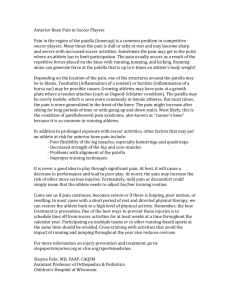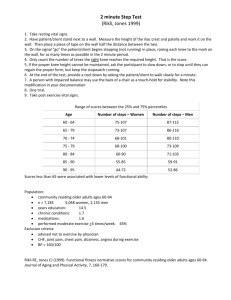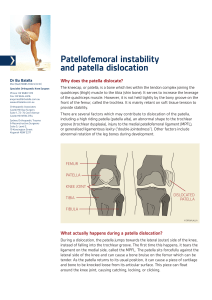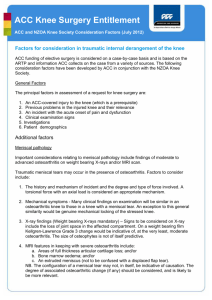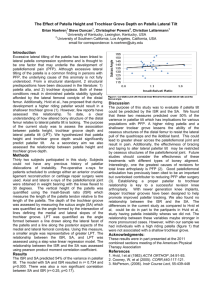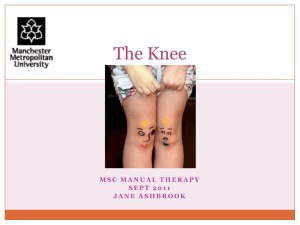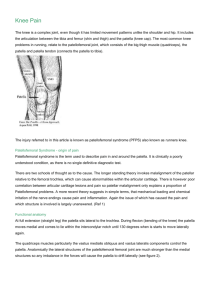Patella Dislocation
advertisement
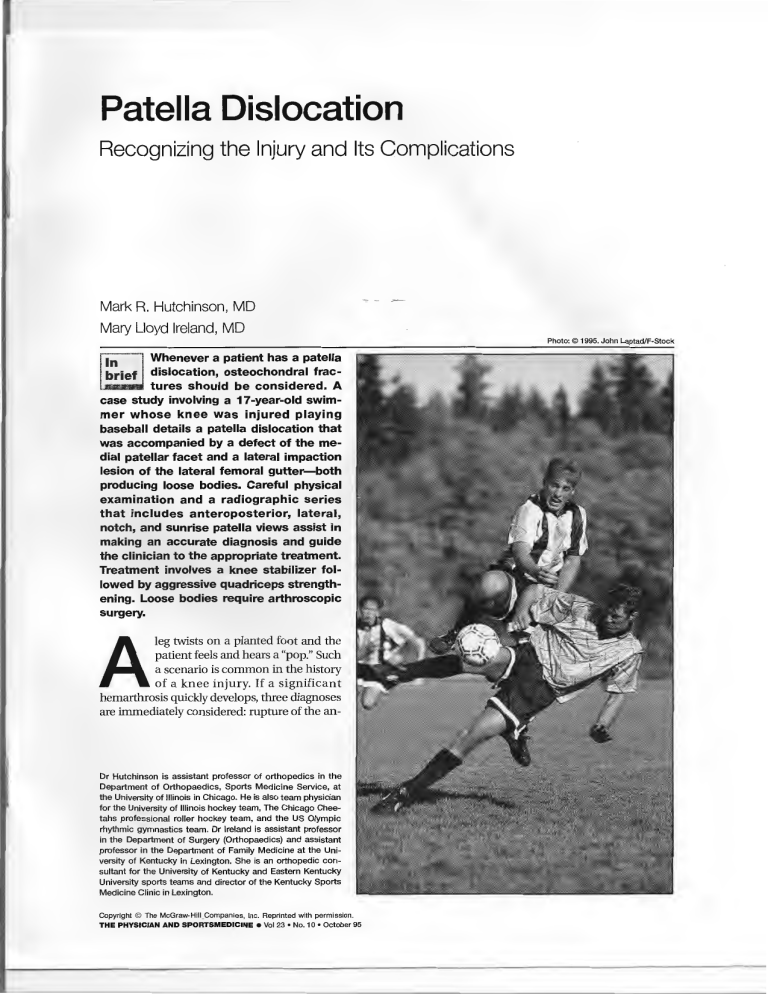
Patella Dislocation
Recognizing the Injury and Its Complications
Mark R. Hutchinson, MD
Mary Lloyd Ireland, MD
Photo: © 1995. John Laptad/F-Stock
Whenever a patient has a patella
dislocation, osteochondral fractures should be considered. A
case study involving a 17-year-old swimmer whose knee was injured playing
baseball details a patella dislocation that
was accompanied by a defect of the medial patellar facet and a lateral impaction
lesion of the lateral femoral gutter-both
producing loose bodies. Careful physical
examination and a radiographic series
that includes anteroposterior, lateral,
notch, and sunrise patella views assist in
making an accurate diagnosis and guide
the clinician to the appropriate treatment.
Treatment involves a knee stabilizer followed by aggressive quadriceps strengthening. Loose bodies require arthroscopic
surgery.
leg twists on a planted foot and the
patient feels and hears a "pop." Such
a scenario is common in the history
of a knee injury. If a significant
hemarthrosis quickly develops, three diagnoses
are immediately considered: rupture of the an-
A
Dr Hutchinson is assistant professor of orthopedics in the
Department of Orthopaedics, Sports Medicine Service, at
the University of Illinois in Chicago. He is also team physician
for the University of Illinois hockey team, The Chicago Cheetahs professional roller hockey team, and the US Olympic
rhythmic gymnastics team. Dr Ireland is assistant professor
in the Department of Surgery (Orthopaedics) and assistant
professor in the Department of Family Medicine at the University of Kentucky in Lexington. She is an orthopedic consultant for the University of Kentucky and Eastern Kentucky
University sports teams and director of the Kentucky Sports
Medicine Clinic in Lexington.
Copyright © The McGraw-Hill _Companies, Inc. Reprinted with permission.
THE PHYSICIAN AND SPORTSMEDICINE e Vol 23 • No. 10 • October 95
Figure 1: Rich Pennell
Figure 1. A diagram of the left
knee indicates possible origins
of osteochondral fractures
caused by patella dislocation.
Contact between the patella
and the femur can damage the
patella (la, lb, and le} and/or
femur (Ila, llb, and lie). The
lateral impaction fracture {lie)
involves the non-weightbearing femoral gutter.
Adapted with permission from Muller
W: The Knee: Form, Function, and
Medial
Lateral
Ligament Reconstruction. New York
City, Springer-Verlag New York Inc,
1983, p 83
terior cruciate ligament (ACL), intra-articular
fracture, and patella dislocation. A peripheral
meniscus tear usually causes a smaller effusion.
In 1905, Kroner 3 was the first to report the
association between patella dislocation and
osteochondral loose bodies. Prior to arthroscopy, multiple authors presented what was
thought to be an uncommon association between patella dislocations and osteochondral
fractures. 2·rn More recent reports state that osteochondral fractures occur in approximately
5% to 30% of acute patella dislocations. 12-16 The
site of origin is most commonly the medial
patellar facet, and more rarely the lateral
femoral condyle. 13•16 The loose fragment may
also originate by impaction of the medial border of the patella on the lateral nonarticulating
condyle of the femur (the lateral impact lesion)
as seen in figure l.' Fractures may be isolated
or associated with other osteochondral fractures.
The following case study provides a framework for reviewing osteochondral fractures and
loose bodies that are often associated with patella dislocations.
Case Report
A 17-year-old competitive swimmer injured
his left knee while playing baseball. He was attempting to catch a fly ball and was struck by another player from the lateral side. He said his
foot was planted and "got stuck;" his knee twisted, then popped. Significant swelling developed
within 30 minutes of the injury. He denied any
previous knee injuries.
On physical examination, the left knee was
significantly swollen and the patella was ballottable. The knee was exquisitely tender over the
medial patella and focally tender over the lateral
aspect of the lateral femoral condyle. Lateral
translation of the patella produced apprehension and pain. Knee range of motion was 10° to
70°. Ligament examination was normal and
symmetrical. There were no meniscal signs. Distal neurovascular status was normal.
Radiographic examination included anteroposterior (AP), lateral, notch, and sunrise patella
views (figure 2). Two osteocartilaginous loose
bodies could be seen radiographically: one in
the lateral gutter and a second one above the
tibial eminence. The osteochondral fragments
were best seen on the notch and sunrise views.
Vol 23 • No. 10 • October 95
e
THE PHYSICIAN AND SPORTSMEDICINE
c
Figure 2. A radiographic series of a 17-year-old
boy's left knee includes anteroposterior (AP) (a),
lateral (b), notch (c), and sunrise patella (d) views.
Patella dislocation during a baseball game led to
osteochondral loose bodies that are best seen in
the AP (a) and sunrise patella (d) views (arrows).
A radiolucent medial lesion of the patella seen on
the sunrise patella view (d} (arrowhead) suggests
the origin of the fragment.
The sunrise patella view also showed increased
patella tilt and lateral subluxation on the affected side compared to the normal side. There was
no genu valgum or patella alta.
The diagnosis of patella dislocation with osteochondral loose bodies was made. Arthro scopic findings are diagrammatically shown in
THE PHYSICIAN AND SPORTSMEDICINE
figure 3a. Arthroscopy was performed to remove
two loose bodies and to locate and saucerize
(debride) the origin of the osteochondral fracture fragment on the medial patellar facet (figure
3b). One osteochondral fragment was seen in
front of the ACL (figure 3c).
The second fragment, from an impaction le-
e Vol 23 • No. 10 • October 95
Figure 3a:Rich Pennell; Figures 3b-3d: Courtesy of Mary Lloyd Ireland, MD
a
Lateral
' \\
I
/.
--'"'\
c
d
Figure 3. A diagram of injuries a 17-year-old boy sustained when his patella dislocated during a
baseball game (a} demonstrates the location of osteochondral fractures involving the patella and
lateral femoral gutter. On arthroscopy, the source of the loose body (b}, a 3 x 3-cm defect in the
medial patellar facet (arrow}, was located and debrided. Note the thickness of the cartilage on the
patella. On an arthroscopic view of the anterior cruciate ligament (ACL} (c}, a large osteochondral
fragment (arrow} was found in the intercondylar notch in front of the ACL. On a view of a 2 x 2-cm
lateral impaction lesion {d) on the lateral aspect of the lateral nonarticulating part of the femoral
condyle in the lateral gutter, shallow impaction of the bone and shearing of the periosteal covering
are noted along with associated smaller loose bodies.
sion of the femoral condyle, was seen in the
nonarticulating femoral gutter (figure 3d). All
other intra-articular structures were normal.
Arthroscopically, the patella tracked centrally in
the femoral groove.
The knee was splinted in extension with a felt
pad placed over the lateral patella. The knee was
immobilized for 3 weeks. Active, active assisted,
and passive range of motion and patellar mobi-
lization were then initiated. Closed kinetic chain
squats and leg lifts limiting the terminal 20° of
flexion were begun 4 weeks postoperatively. The
patient attained 90° range of motion 2 months
after surgery and regained full range of motion
at 3 months. He was urged to wear a lateral
padded knee sleeve during all lifting activities
and running. The patient resumed swimming
competitively 3 months after surgery.
Vol 23 • No. 10 • October 95 e THE PHYSICIAN AND SPORTSMEDICINE
How Do Fractures Occur?
Table 1. Differential Diagnosis of
The patella fracture may occur from the disAcute Knee Hemarthrosis
location or the reduction. Most feel the chondral
injury occurs as the patella dislocates. If the inAnterior cruciate ligament rupture
Patella dislocation/subluxation
jury occurs with the knee flexed in forced inward
Osteochondral fracture (patella, femur, tibia)
rotation of the femur with a fixed externally roMedial or lateral meniscus tear
tated tibia, the fracture should occur during dis_ Posterior cruciate ligament rupture
location:1'·16The patella or femoral condyle fracIsolated popliteal tendon rupture
tures as the patella dislocates over the promiBleeding dyscrasias
nence of the lateral condyle.
Muller,1 however, argues that reduction creates the osteochondral fragment. He notes that if
rotation was part of the disloq1tion mechanism, vastus medialis insertion, .and.apprehension on
a meniscus tear:wouldbe present--yet none has lateral subluxation .of the;patella....Tendemess to
ever been reported. Muller presented two cases palpation on the middle to posterior lateral
of patellar dislocation secondary to isolated in- femoral condyle just above the tibiofemoral joint
ternal rotation of the tibia. He argued that the line but away from the patellofemoral articuladislocation occurred in extension with contrac- tion should raise suspicion. Pain on palpation of
tion of the vastus lateralis. In this portion, the the lateral femoral gutter just above the joint line
path of least resistance is above the lateral suggests a lateral impaction lesion. On examinacondyle, which would have no bony obstruction tion, the ligaments are usually stable. Meniscus
to cause an osteochondral fracture. The osteo- tears are rarely associated with patella disloca chondral fracture, he argued, would therefore tions. 1"
An extended differential diagnosis (table 1) is
occur with reduction as the patella pops back into place over the lateral condyle.
considered if history and physical exam are not
The lateral impaction lesion occurs when the classic. If there was no traumatic episode, infecpatella is completely dislocated and the vastus tion, bleeding disorder, or tumor should be conmedialis and quadriceps force the medial border sidered.
of the patella into the lateral femoral condyle.
Unlike a flake fracture of the anterior femoral Select the Best Radiographic Views
condyle, the lateral impaction lesion does not
If patella subluxation or dislocation is susinvolve the weight-bearing articular surface and pected, four views of the knee (AP, lateral, notch,
is more posterior and nearer to the tibiofemoral and sunrise patella view) are carefully reviewed.
Radiopaque loose bodies should be searched
joint line.
for. The sunrise view may provide the only findings oflateral subluxation or loose bodies. Notch
Examine for All Damage Sites
In an athlete who presents with an acute views may expose loose fragments that were
knee injury accompanied by a significant hidden by overlapping shadows in routine AP
hemarthrosis, the two most common diagnoses views. Lateral views may visualize fragments or
are patella dislocation and ACL injury. Meniscus demonstrate patella alta, which predisposes the
tears and intra-articular fractures may also de- patient to patella subluxation. Oblique views
velop an effusion; those from meniscus tears are may be added if suspicion of loose fragments is
usually of less volume and those from intra-ar- high but visualization has not been accomplished. It is helpful to look for subtle radioluticular fractures may contain fat droplets.
A thorough physical exam often confirms the cencies in all possible sites where osteochondral
diagnosis of patella dislocation. Consistent find- fragments may be missing.
ings include a voluminous hemarthrosis, focal
Lateral impaction lesions may not be visualtenderness over the medial retinaculum and ized on plain radiographs. Diagnosis, debride-
THE PHYSICIAN AND SPORTSMEDICINE
e Vol 23 • No. 10 • October 95
ment of the lesion, and loose body removal are
performed,arthroscopically.
Loose Bodies Guide Treatment Decisions
The treatment goal for any patient who has a
patella dislocation is to restore normal knee
function. 17
In our practice, we base treatment for an
acute patella dislocation without osteochondral
fragments on predisposing factors for recurrent
dislocation. A careful physical exam is necessary
to identify the at-risk patient. Factors increasing
the risk of recurrent dislocation include excessive genu valgum, increased Q angle, patella alta,
generalized ligamentous laxity. a relatively low
lateral femoral condylar height, a defect of the
vastus medialis obliquus insertion onto the
patella, vastus medialis obliquus dysplasia, or
abnormal patella configuration. 18· 20 If any of
these conditions is present, a more aggressive
surgical approach may be needed. Open patellar
realignment procedures may be required if subsequent dislocations occur.
If no predisposing factors are present, a conservative approach may be attempted that consists of knee immobilization in extension for 3
weeks, a lateral pad or taping to maintain reduction of the patella, and aggressive quadriceps rehabilitation. Patients can generally return to play
in 8 to 12 weeks. However, some authors2023 advocate surgical repair for most patients and for
all athletes with an acute patella dislocation regardless of predisposing factors. Others24 advocate diagnostic arthroscopy in all cases of acute
hemarthrosis. In one series,25 preoperative physical examination yielded the correct diagnosis of
an osteochondral fracture in only 17% of the patients.
Chondral loose bodies are not seen radiographically. Therefore, if the patient experiences
recurrent swelling, locking, or can feel or show
the physician the loose fragments, arthroscopy
is indicated.
Surgery is clearly indicated if osteochondral
loose bodies are seen on radiographs and the
history and physical exam suggest patella dislocation. Arthroscopy is a valuable tool for identifying intra-articular pathology and removing
loose osteochondral fragments. If any predisposing factors for patella dislocationare present,
an.even more aggressive approach should be instituted. For mild to moderate predisposing factors in the proximal aspect of the extensor
mechanism (such as a lax or tom medial quadri__£eps retinaculum, vastus medialis dysplasia, or
retracted insertion of the vastus medialis obliquus on the patella), arthroscopy can be accompanied by a lateral retinaculum release and medial
retinaculum repair or reefing through a small
medial parapatellar incision. For significant predisposing factors involving bony alignment or
severe soft-tissue imbalance (such as severe
generalized ligamentous laxity. excessive Q angle, low lateral femoral condyle, or severe genu
valgum) an open repair with bony osteotomy
and realignment may be indicated. Fortunately,
a large majority can be treated with arthroscopy
with the occasional addition of a small medial
parapatcllar repair.
In comparison to open repair and realignment, arthroscopic treatment with or without
the mini-medial repair reduces postoperative
pain, allows an accelerated rehabilitation program, and facilitates an earlier return to sports
participation.
Postoperatively, we generally splint the knee
in extension and place a felt pad over the lateral
aspect of the patella to maintain reduction. The
knee is immobilized for 3 weeks, after which the
patient wears a knee sleeve with a lateral pad
and begins active, active assisted, and passive
range of motion of the knee and patellar mobilization activities. At 4 weeks, closed-chain
squats and leg press activities limiting the terminal 20° of extension are begun. Motion is progressed, and a range from 0° to 90° is expected by
6to8weeks.
The quadriceps strengthening program involves closed-chain exercises through the painless arc, single or double legged squats or leg
presses in an arc of 0° to 60°. Open-chain exercises such as straight-leg raising with ankle
weights are best performed in near-full extension, when patellofemoral articulation forces are
minimized.
Return to full functional activity should be
Vol 23 • No. 1 0 • October 95 • THE PHYSICIAN AND SPORTSMEDICINE
based on ability to perform a single-leg leg
press at a level comparable to the opposite side,
along with restoration of landing balance ability specific to the patient's sport. The knee
sleeve should be worn during contact or vigorous stop-cut activities for at least the remainder
of the season. As long as rehabilitation contin- ues, weakness from dependence on the knee
sleeve is not observed. The patient can usually
return to sports in 3 months. The physician
should urge the patient and coach to continue
the patient's quadriceps strengthening exercises and to use a knee sleeve, .acquire .sports-specific skills, and employ proper knee biomechanics.
References
1. Muller W: The Knee: Form, Function, and ligament
Reconstruction. New York City, Springer-Verlag New
York Inc, 1983, pp 80-84
2. Morscher E: Cartilage-bone lesions of the knee joint
following injury. Reconstr Surg Traumata! 1971;
12(0):2-26
3. Kroner M: Ein fall von flachenfraktur und luxation
der patella. Deutsche Medizinische Wochenschrift
1905;31(24):996-997
4. Kleinberg S: Vertical fracture of the articular surface
of the patella. JAMA 1923;8l(l4):1205-1206
5. Krida A: Osteochondral fracture of the knee joint.
SurgGyn Obstet 1924;39(6):791-795
6. Meekison DM: A hitherto undescribed fracture of
the patella. Br J Surg 1937;25(97):64-65
7. Milgram JE: Tangential osteochondral fracture of the
patella. J Bone Joint Surg 1943;25:271
8. Coleman HM: Recurrent osteochondral fracture of
the patella. J Bone Joint Surg 1948;30B: 153-157
9. Harmon PH: Intra-articular osteochondral fractures
as a cause for internal derangement of the knee in
adolescents. J Bone Joint Surg 1945;27(4):703-705
10. Ahstrom JP Jr: Osteochondral fracture in the knee
joint associated with hypermobility and dislocation
of the patella: report of eighteen cases. J Bone Joint
Surg (Amer) 1965;47:1491-1502
11. McDougall A, Brown JD: Radiological sign of recurrent dislocation of the patella. J Bone Joint Surg (Br)
1968;50(4) :841 -843
12. Frandsen PA, Kristensen H: Osteochondral fracture
associated with dislocation of the patella: another
mechanism of injury. }Trauma 1979;19(3) :195-197
13. Rorabeck CH, Bobechko WP: Acute dislocation of
the patella with osteochondral fracture: a review of
eighteen cases. J Bone Joint Surg (Br) 1976;58(2):
237-240
14. Hammerle CP, Jacob RP: Chandra! and osteochondral fractures after luxation of the patella and their
Minimize Down Time
Keeping in mind that multiple chondral or
osteochondral defects may be present when a
patient sustains a patella dislocation, a careful
physical exam, an appropriate radiographic series, and arthroscopy when needed will guide
treatment.
Structured rehabilitation for injuries without
fragments or defects and prompt arthroscopic
treatment for those with fragments or defects
help accomplish the goal of restoring knee function and returning patients to their activities. PEM
Address correspondeBce to Mary Lloyd Ireland, MD,
Kentucky SpOFts Medicine, 601 Perimeter Qr, L.exingtoR,
KY40517.
15.
16.
17.
18.
19.
20.
21.
22.
23.
24.
25.
treatment. Arch Orthop Trauma Surg 1980;97(3):
207-211
Kradel A, Refior HJ: [Patellar dislocation as a cause
of osteochondral fracture of the femoro-patellar
joint] Urrfallchirurgie 1990;16(1):12-17
Isaacs CL, Schreiber FC: Patellar osteochondral fracture: the urrforeseen hazard of golf. Am J Sports Med
1992;20(5):613-614
Cash JD, Hughston JC: Treatment of acute patellar
dislocation. Am J Sports Med 1980;16:224
Hawkins RJ, Bell RH, Anisette G: Acute patellar dislocations: the natural history. Am J Sports Med 1986;
14(2):117-120
Larsen E, Lauridsen F: Conservative treatment of
patellar dislocations: influence of evident factors on
the tendency to redislocation and the therapeutic
result. Clin Orthop 1982;(171):131-136
Cofield RH, Bryan RS: Acute dislocation of the patella: results of conservative treatment. J Trauma 1977;
17(7):526-531
Bassett FH III: Acute dislocation of the patella, osteochondral fractures, and injuries to the extensor
mechanism of the knee. MOS Instructional Course
Lectures 1976;25:40
Bori..ngTH, O'Donoghue DH: Acute patellar dislocation: results of immediate surgical repair. Clin Orthop 1978;0ct(l36):182-185
Vainionpaa S, Laasonen E, Silvennoinen T, et al:
Acute dislocation of the patella: a prospective review
of operative treatment. J Bone Joint Surg (Br) 1990;
72(3):366-369
Dainer RD, Barrack RL, Buckley SL, et al: Arthroscopic treatment of acute patellar dislocations. Arthroscopy 1988;4(4):267-271
Bamberg BC, McGinty JB: Acute hemarthrosis of the
knee: indications for diagnostic arthroscopy. Arthroscopy 1990;6(3):221-225
Vol 23 • No. 1 0 • October 95
e THE PHYSICIAN AND SPORTSMEDICINE
